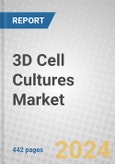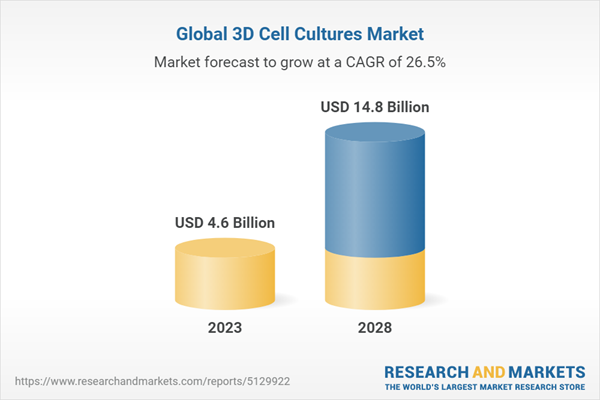This report aims to provide a comprehensive study of the global 3D cell culture technologies market. It provides a detailed description of the different types of healthcare interoperability solutions and their current and historical market revenues.
The scope of the report encompasses the major types of 3D cell culture which are being used by industry, academic researchers, government labs, and independent research groups. This includes the main inputs such as cell lines, media, sera, reagents, software, and instrumentation. It analyzes the current market status, examines future market drivers and presents forecasts of growth over the next five years.
The market structure has been reorganized for this edition. Also, more research was done on base case data for different product areas. The greater emphasis is on the different products used for 3D cell culture, but the report also investigates the market in terms of types of applications, end users and geographic regions.
Report Includes
- 17 data tables and 105 additional tables
- An overview of the global market landscape related to the 3D cell cultures technologies
- In-depth analysis of global market trends, featuring historical revenue data for 2020-2022, estimated figures for 2023, as well as forecasts for 2028. This analysis includes projections of Compound Annual Growth Rates (CAGRs) spanning through 2028
- Evaluation of the current market size and revenue growth prospects specific to 3D cell cultures technologies, accompanied by a comprehensive market share analysis categorized by type, end user, and geographical region
- Information on analytical systems used in tissue and cell culture, cellomics, and human cancer model initiative (HCMI)
- Details about assay development for mesenchymal stem cells, In Vitro testing of adventitious agents and description of assays and assay kits
- A look at the main classes of models for researching cancer and other diseases, benefits of 3D models to cancer research and description of 3D engineered scaffolds
- Analysis of the market's dynamics, specifically growth drivers, restraints, and opportunities and discussion on the impact of COVID-19 on the world of cell culture
- Insights into U.S. regulatory status of bioprinted products; basic guidance for the regulation of biologics, regenerative medicine and xenotransplants
- Relevant patent analysis, including recent activity and a list of key patents
- Detailed profiles of leading market participants, providing a descriptive overview of their respective businesses, including Abcam PLC, Agilent Technologies Inc., Corning Inc., Merck KGAA, Beckman Coulter, and Synvivo Inc.
Table of Contents
Executive Summary
This chapter also offers both fundamental information and important matters in the market. These include an introduction to basic distinctions such as the differences between in vitro and in vivo and changes in the marketplace. It also deals with matters that need closer scrutiny, such as the growing calls for standardization and how innovation is taking on new and unexpected features affecting future commercialization initiatives.3D cell culture technologies are a powerful tool for studying cell biology, disease mechanisms and drug discovery. 3D cell culture models mimic the 3D structure and cell-cell interactions that are found in real tissues, making them more accurate and predictive than traditional 2D cell culture models.
There are a variety of 3D cell culture technologies available, including -
- Scaffold-based 3D cell culture: This approach uses a scaffold to provide a 3D support structure for cells to grow on. Scaffolds can be made from a variety of materials, including natural polymers, synthetic polymers and hydrogels.
- Scaffold-free 3D cell culture: This approach does not use a scaffold. Instead, cells are grown in a suspension of culture medium and gel-forming agents, such as collagen or Matrigel.
- Bioprinting: This approach uses a 3D printer to deposit cells and biomaterials layer-by-layer to create complex 3D cell culture models.
3D cell culture technologies have a wide range of applications, including -
- Drug discovery: 3D cell culture models can be used to screen new drug candidates for safety and efficacy before they are tested in clinical trials. 3D cell culture models can also be used to study the mechanisms of drug resistance and to develop new strategies to overcome drug resistance.
- Disease modeling: 3D cell culture models can be used to study the biology of diseases and to develop new treatments. For example, 3D cancer models can be used to study tumor growth and metastasis, and 3D neurodegenerative disease models can be used to study the progression of neurodegenerative diseases.
- Regenerative medicine: 3D cell culture models can be used to develop new cell-based therapies for a variety of diseases. For example, 3D skin models can be used to grow new skin for patients with burns or other skin injuries, and 3D liver models can be used to grow new liver tissue for patients with liver disease.
Companies Mentioned
- 3D Bioprinting Solutions
- 3D Biotek Llc
- 4D Technology Corp.
- Abcam Plc
- Akron Biotech
- Agilent Technologies Inc.
- Alpco
- Amsbio
- Beckman Coulter Inc.
- Bioinspired Solutions
- Biotime Inc.
- Biovision Inc.
- Cell Applications Inc.
- Cellink
- Corning Inc.
- Cyprotex
- Cytiva
- Cytoo Sa
- Emd Millipore / Merck Kgaa
- Emulate Inc.
- Envisiontec Inc.
- Epithelix
- Eurofins Sas
- Greiner Bio-One International Gmbh
- Hamilton Robotics
- Hub Organoids
- Hurel Corp.
- Insphero
- Invitrocue
- Kiyatec Inc.
- Lifenet Health
- Lorem Vascular / Cytori Therapeutics Inc.
- Mattek
- Mimetas Inc.
- Organovo Holdings Inc.
- Perkinelmer Inc.
- Plasticell Ltd.
- Pluristem Therapeutics Inc.
- Poietis
- Promega Corp.
- Seahorse Bioscience
- Stemcell Technologies
- Stratatech Corp.
- Synvivo Inc.
- Tap Biosystems
- Tecan Trading Ag
- Zen-Bio Inc.
Table Information
| Report Attribute | Details |
|---|---|
| No. of Pages | 442 |
| Published | February 2024 |
| Forecast Period | 2023 - 2028 |
| Estimated Market Value ( USD | $ 4.6 Billion |
| Forecasted Market Value ( USD | $ 14.8 Billion |
| Compound Annual Growth Rate | 26.5% |
| Regions Covered | Global |
| No. of Companies Mentioned | 47 |









